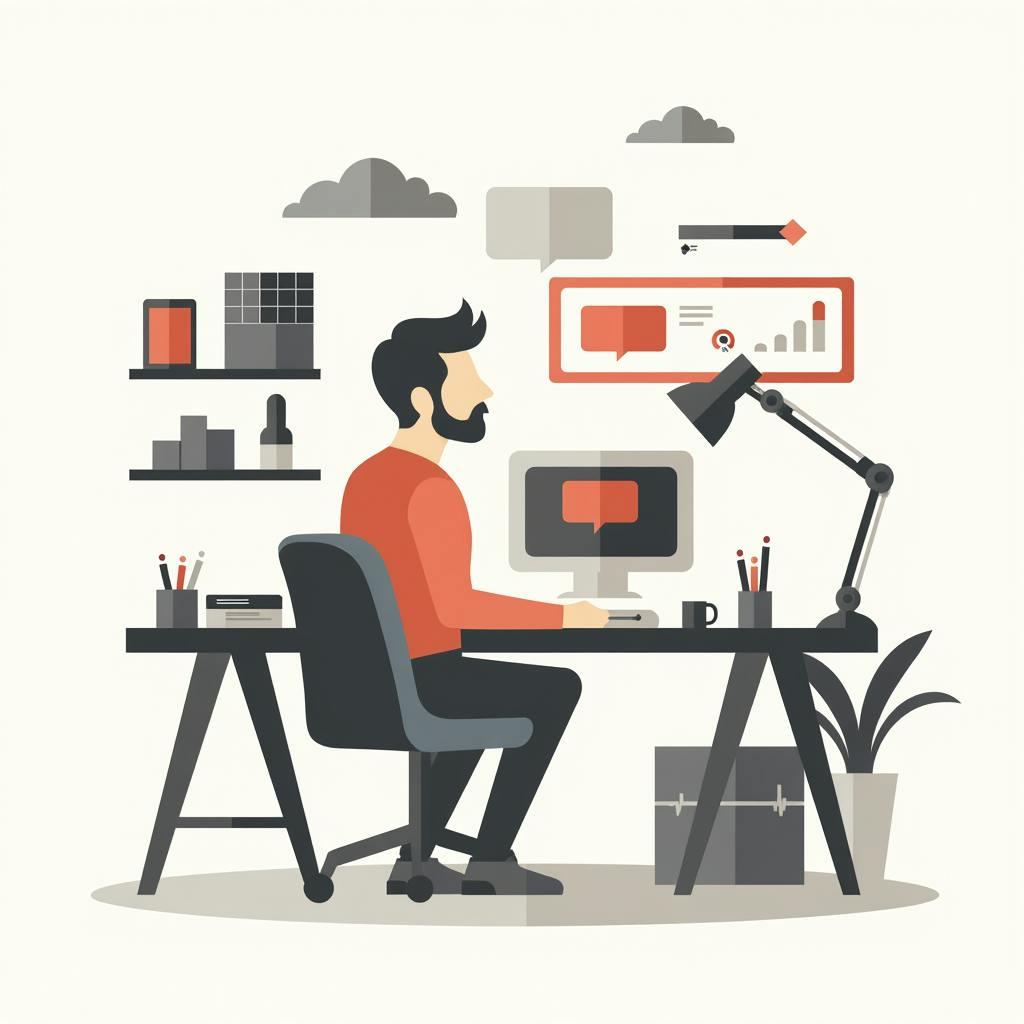Email newsletters are still one of the best ways to connect with your audience. But their success often comes down to getting the format right. A clear, simple newsletter format for email can help your message stand out and improve your results. In this article, we’ll break down how to design an effective format, share examples of top email newsletter templates, and explore where to find great free options.
Keep It Clear and Easy to Read
The main goal of any email newsletter is clarity. Since most people skim their emails, your message should be easy to understand right away. Readers should know what you're offering within seconds of opening it. A simple newsletter format for email makes this easier by organizing your content clearly and highlighting the key points.
Keep your message short and focused. Long emails can lose attention fast. When you stick to the main idea and get to the point quickly, your readers are more likely to stay engaged. A good format helps deliver your message without overwhelming your audience.
Use Great Content and Strong Design
Your newsletter should be both helpful and interesting. Great content paired with clean, eye-catching design keeps people reading. Use clear calls-to-action (CTAs) to guide readers—whether it’s to read a blog post, sign up for a webinar, or make a purchase.
To build trust, your content needs to be honest, useful, and relevant. Adding customer reviews, case studies, or real data can show your audience that they can rely on you.
Key Elements of an Effective Newsletter Format for Email
- Subject Line & Preheader Text: The subject line is the first thing your audience sees, so it needs to grab attention fast. It should spark curiosity and give a quick hint about what the email is about. Right after that, the pre-header text should build on that interest and encourage the reader to open the email.
- Header: The email header sets the tone for your message and should visually represent your brand. It usually features your logo and may include links to your website or social media, helping readers explore more about your brand easily.
- Body: The body of your newsletter is where the main message goes. Make it easy to read by combining text with images. Split the content into clear sections such as a main image, subheadings, and short points. This helps readers quickly understand the key ideas. Each section should focus on one topic, with pictures or icons that support the message.
- Footer: End your newsletter with a clean, organized footer. Include links to your social media, your contact details, and an easy way for readers to unsubscribe. A simple and professional footer helps people find what they need and shows that your brand is trustworthy.

AI made with Dean Jones
Finding the Best Email Newsletter Templates
There are many platforms that offer high-quality email newsletter templates for various industries and styles. Sites like Canva, HubSpot, and Mailchimp provide professional, easy-to-customize templates that can help you build a newsletter format for email that fits your brand and audience.
Are Free Templates Worth Using?
Yes—many free email newsletter templates are great starting points, especially for beginners. Canva and Mailchimp both offer free versions that are easy to edit and mobile-responsive. These templates allow you to focus on content without worrying about layout from scratch.
Making Your Newsletter Mobile-Friendly
Most email marketing tools come with responsive design features to ensure your emails display correctly on phones and tablets. Still, it’s a good idea to preview or test your email on different devices. This ensures that your layout, images, and text are easy to read no matter how your subscribers open it.
How Often Should You Send Newsletters?
The right frequency depends on your content and your audience’s expectations. Weekly or monthly newsletters are most common. What matters most is consistency—sending on a regular schedule builds trust. Just make sure not to overload your readers with too many updates.
FAQ: Newsletter Format for Email
Creating an engaging email newsletter is a cornerstone of any successful email marketing strategy. A strong newsletter format helps deliver your message clearly, keeps readers interested, and supports long-term audience engagement. Below is a breakdown of the most effective format elements and how to use them.
What Is the Best Format to Use for an Engaging Email Newsletter?
The ideal newsletter format for email depends on your audience, industry, and goals. However, most effective newsletters follow a simple and consistent structure that includes a few key components.
Start with a strong header that features your brand logo and the newsletter title. This not only sets the tone but also reinforces brand recognition.
Follow the header with a brief introductory message. This should welcome your readers and give them a quick preview of what’s inside. Keep it warm, friendly, and concise.
The heart of your email lies in its content blocks. These should be organized into clearly defined sections. Begin with a featured article or highlight—something timely, relevant, and engaging. After that, include secondary content such as tips, updates, or list-style insights. To enhance the experience, add visuals like photos, infographics, or short videos that support your written content.
Throughout the email, place clear and compelling calls to action (CTAs). Whether you want the reader to visit your blog, register for an event, or make a purchase, your CTAs should be easy to find and visually distinct.
End with a clean, professional footer. Include contact information, links to your social media channels, and a visible unsubscribe option to maintain trust and comply with email marketing regulations.
Consistency is key. Using the same general structure each time helps readers know what to expect, while fresh content and design elements keep your newsletters engaging over time.
How does the right format contribute to the success of email newsletters?
- Readability
A good layout makes it easy for people to read and find what they need quickly. This keeps them interested instead of clicking away. - Brand Consistency
Using the same look and feel in every newsletter helps people recognize your brand right away. - Delivery of Value
Clear sections help you share useful info—like tips, deals, or news—in a way that’s easy to follow. - CTAs guide
Simple and clear call-to-action buttons or links tell readers exactly what to do next, like reading more, buying something, or signing up. - Visual Appeal
A clean design with images, colors, and clear headings makes your email look better and more fun to read.

AI made with Dean Jones
What are some tips for mastering the right format for my email newsletter?
- Know Your Audience
Think about what your readers like. Use feedback and data to shape your format and make your content more useful to them. - Mobile Responsiveness
Make sure your newsletter looks good on phones. Most people will read it on a mobile device. - Short and Sweet
Keep your message simple and clear. Long emails can be hard to follow and might make readers lose interest. - Visual Hierarchy
Use headings, subheadings, and bullet points to organize your content. This makes your newsletter easier to read and more engaging. - A/B testing
Try out different formats to see what works best. A/B testing helps you learn what your audience responds to. - Engaging Visuals
Add pictures, GIFs, or videos that support your message—but don’t let them take over the email. - Proper Use of White Space
Don’t cram everything together. Leave enough space so each section is easy to read and doesn’t feel overwhelming.
How can I tailor my email newsletter format to increase reader engagement?
- Personalization
Make the email feel personal by using the reader’s name in the subject line and writing content based on what they’ve clicked or liked before. - Interactive Elements
Add fun features like polls, quizzes, or clickable buttons to get readers more involved. - Segmented Lists
Send different content to different groups of people. Match your format and message to what each group is most interested in. - User-Generated Content
Include customer reviews, testimonials, or stories shared by your readers. It makes the newsletter feel more real and community-driven. - Storytelling
Tell short stories your readers can relate to. It helps build a connection and keeps them reading. - Feedback Loops
Ask your readers what they think about your newsletter. Use their feedback to improve your format and content over time.
Conclusion
Testing and improving your newsletter format over time can help boost how readers respond to your emails. Finding the right newsletter format for email is key to building trust and keeping your audience engaged. Clear, simple, and helpful content makes it easier to connect with your subscribers.
Whether you use ready-made templates or free ones, your goal should be to share useful information in a way that’s easy to read and looks good. With the right format, you can give readers a better experience and get better results from your email campaigns.

